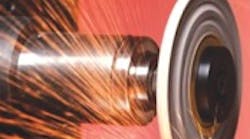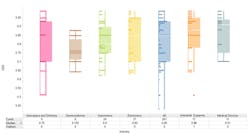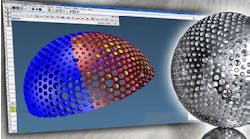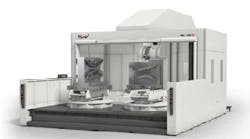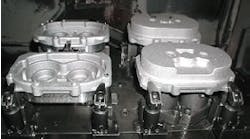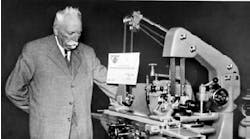Silicon carbide wheels have a hard, sharp abrasive grain. Photo courtesy Warren/Amplex Superabrasives.
Diamond wheels are good for grinding cemented carbides and CBN wheels are good for sharpening high speed steel tools.
SELECTING THE BEST GRINDING WHEEL FOR A JOB COMPELS A SHOP TO MATCH the characteristics of the wheel's basic components — its abrasive and its bonding system — with the requirements of the application. Bonded abrasives, such as those in grinding wheels, are made up of grains that are held together by a fixative material. Coated abrasives, such as used in belt, disc, roll, sheet, and flap-wheel products, consist of abrasive grains that are built onto a cloth or paper backing. The classification of abrasives and bond materials and their basic characteristics is rather straight-forward. However, manufacturers incorporate many proprietary additives and fillers that give these materials unique characteristics that must be considered when matching application performance and finish requirements.
Families of abrasive formulations include aluminum oxides, silicon carbides, ceramic grain abrasives and the superabrasives — diamond and cubic boron nitride (CBN).
Aluminum oxides
Aluminum oxide consists of blunt shaped grains and is very tough in its lowest refined form. During the melting stage in the production of aluminum oxide, the crystalline structure and its chemistry can be controlled, allowing the manufacturer to produce a family of products that perform differently. Aluminum oxide is produced in a variety of types, and its versatility makes it the most commonly used abrasive.
White fused aluminum oxide is softer, or more friable, than other abrasives. It has high chemical purity (more than 99 percent Al2O3) that gives it an aggressive, cool, fast-cutting action. White-fused aluminum oxide holds its form well. It is used to grind heat-sensitive alloys. These applications make use of its friability and the fact that it cuts without generating high heat. This grain is also used to gring heat treated tool steels, high speed steels, and for internal grinding wheels.
Aluminum oxide fused with chrome oxide is a pink abrasive that is used in grinding applications that require slightly more toughness than white fused aluminum oxide. The chrome oxide component of the abrasive enhances its grinding capacity. Although friable and cool cutting, aluminum oxide fused with chrome oxide exhibits strong form-holding characteristics. It is used for precision, broad surface and toolroom grinding on hard alloy steels.
Brown fused aluminum oxide includes 2 to 4 percent titanium oxide (TiO2) to enhance toughness. (Titanium oxide is also known as titania.) This is the most widely used abrasive, and is used to grind high-tensile-strength materials, and for rough grinding, deburring and snagging, as well as to cut low-alloy, ferrous materials.
Low titania brown fused aluminum oxide has 1 to 2 percent TiO2 content, and is used in bonded or coated applications that require an abrasive that is slightly tougher than white aluminum oxide. Reducing the titania content reduces the abrasive's toughness, but increases its friability.
Zirconia-alumina is the toughest of the alumina-based abrasives, and is used in bonded, coated and sandblasting applications that require an extra tough abrasive.
Ceramic aluminum oxide is a nonfused, ceramic compound with a fine grain. It is very tough, pure, and can be produced with uniform quality. It provides exceptional durability and cut rates, and does not generate excessive heat. It is used for high stock removal rates and in applications in which long life of the grinding tool is needed. It is available in resin and vitrified points, and wheels. Ceramic aluminum oxide performs especially well in precision grinding and finefinish applications on steels and alloys that are difficult to grind.
High chromium aluminum oxide is a ruby-colored, fused abrasive, that is free of titania. It is made by fusing high purity, calcined alumina and chromium oxide. It is a friable abrasive,and is somewhat tougher than white aluminum oxide, it has good corner-holding characteristics that are needed for precision grinding.
Silicon Carbide
Silicon carbide is a hard, sharp abrasive that has exceptional strength. However, due to its brittleness, it breaks down faster than aluminum oxide under heavy loads.
Black silicon carbide is a semifriable, medium-density abrasive. It is produced in both resin and vitrified points and wheels, and is used to gring hard or brittle materials; such as cast iron, ceramics, and glass. It also is used to grind low-tensile-strength, ductile nonferrous metals.
Green silicon carbide is the highest purity silicon carbide. It is a friable, medium density abrasive that is used in vitrified, bonded points and wheels. It is most commonly used for grinding hard, brittle materials, such as cemented carbides, where fast, cool cutting is desirable.
Superabrasives
Diamond and cubic boron nitride — the superabrasives — rarely wear before the bond that holds them in place deteriorates. Both natural and synthetic diamonds are used as abrasives, and within the diamond family are monocrystalline, polycrystalline, natural and ultra-detonated diamond. Boron nitride is man-made and has no natural counterpart. It exists as cubic crystals and polycrystalline types.
Diamond is the hardest material known. However, it has limitations in grinding applications. At temperatures above 1,220°F (660°C) a graphitization effect occurs, and when diamonds are used to grind carbon steels, a chemical reaction can occur between the two forms of carbon that reduces the diamond's superabrasive property.
As a metal-removal or shaping tool, diamond is most effective in off-hand and precision grinding of tungsten carbide, glass and ceramic-part processing as in hip and dental prostheses, carbides as in wire drawing and glass processing. Resin-bonded diamond products have mild- to fastcutting properties. Vitrified-bonded diamond wheels, are more fragile than resin-bonded wheels, but are freer cutting at the same metal removal rate. Metal-bonded diamond wheels are used in severe applications such as cut-off wheels in which high mechanical strength is required.
Cubic boron nitride (CBN) is second only to diamond in hardness, and exceeds diamond abrasives in thermal stability. It is useful at temperatures to 3,632°F. (2,000°C). Applications for CBN include grinding hard ferrous metals, cast iron, nickel and cobaltbased alloys. In automotive applications it is the abrasive used to grind chilled cast iron crankshafts or 1050 steel camshafts.
An increased number of grades of CBN abrasive grains become available in recent years for precision grinding. The shapes of these grades are closely controlled as they are made, and the grades have increased thermal toughness. The challenge for grinding wheel manufacturers has been to develop bonding systems that capitalize on the increasing toughness of these new abrasive grains. Because the grits are tougher, they require stronger, more resilient bonds to provide economic benefits.
These new CBN grits and a new glass bonding technology that incorporates either high-strength glasses or glass-ceramic bond systems, to maximize strength, toughness, and wear resistance. Engineers at the companies that have developed these grades, in collaboration with machine tool builders, have tested process variables to optimize grinding cycles, and report that they have achieved desired economic benefits in high-volume, ultraprecision I.D. and O.D. grinding of ferrous materials, including cast iron, steel, and high-nickel alloys. This new generation of vitrified CBN wheels can be used in the production of automotive camshafts, crankshafts and fuel injectors and in form grinding products, such as blades for jet engines.
Increases in wheel life by as much as double have been reported in applications that used the new bonding platform and premium abrasives, compared with wheels made with standard bond systems.
| What's It Mean? Semifriable abrasive grains do not fracture as readily as friable grains. This results in longer grain life during grinding, but semifriable grains do not cut as freely as friable grains. |
| Holding the Grains Together The art of grinding wheel manufacturing involves balancing the amount of abrasives with the volume and the porosity of the bonding material to produce the desired characteristics in the cutting tool. Vitrified bonds are a very hard and brittle. Typically, they are glass or ceramic bonds. They remove material at high rates and are not affected by water, acid, oils or variations in temperature. Resin bonds are strong, tough and resilient, and are more resistant to shock and heavy-duty service than vitrified bonds.They usually are used for snagging operations. This type of bond is used for grinding wheels designed for fast stock removal and fine finishes, and also works well on stainless steel, brass, bronze and aluminum. Rubber bonds are used in wheels in which a high quality finish is required, such as for grinding bearing races. |
| Treatments for Improved Performance Sulfur treating improves cutting action and results in cooler operation. Sulfur-treated abrasives should be used with a flood coolant. Resin treating hardens the abrasive and adds lubrication to assist in cutting. Wax treating is common for grinding brass or aluminum because it reduces loading and lubricates the cutting action. |
Contributors to this article include:
Warren Amplex Superabrasives (Saint-Gobain Inc.) (www.warrenamplex.com)
Norton Superabrasives (Saint-Gobain Inc.) (www.nortonabrasives.com)
Grier Abrasive Co. Inc. (www.grierabrasives.com)
Camel Grinding Wheels (www.cgwheels.com)
K.C. Abrasive Co. (www.kcabrasives.com)
Photo courtesy Saint-Gobain Abrasives Inc.
